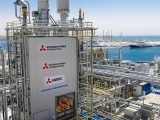
Hydrogen Production Ramps Up as Cummins’ Q2 Power Systems Shine
August 7, 2025You wouldn’t expect a century-old diesel engine maker to pull a rabbit out of a hat and post record profits just as its bread-and-butter business shrinks — but that’s exactly what Cummins Inc. did in Q2 2025. Based in Columbus, Indiana, the company saw revenue dip 2% to $8.64 billion, yet somehow hit all-time highs for its Power Systems (+19%) and Distribution (+7%) segments. At the same time, its legacy Engine and Components lines took a noticeable dive, signaling a clear shift toward zero-emission technology and higher-value power solutions.
Core News Summary
By the end of the quarter on June 30, 2025, Cummins was looking at $8.64 billion in revenue — off about 2% year-over-year — but its operating income climbed an impressive 8% to a record $1.2 billion. The Power Systems division stole the show, jumping 19% thanks to booming orders for the new 17L engine generator, which can crank out up to one megawatt of backup or continuous juice for data centers and other mission-critical sites. Meanwhile, the Distribution side had a solid 7% lift, driven by aftermarket parts and service demand. But the classic Engine and Components arms weren’t so lucky, each slipping into double-digit declines amid a softer North American on-highway truck market.
Company Background
Founded in 1919, Cummins Inc. has come a long way from its early days as a diesel-engine innovator. These days, it runs four main segments — Engine, Power Systems, Components and Distribution — plus a rising star in Accelera, its zero-emission technology arm. Headed by CEO Jennifer Rumsey since 2022, the company’s sharpening its focus on operational efficiency, branching out into new markets, and plowing cash into sustainable energy innovations. With over 600 company-owned and independent distribution centers around the globe, Cummins has set some ambitious targets: net-zero operations by 2050 and a 55% cut in product lifecycle greenhouse gas emissions by 2030.
Historical Context and Market Dynamics
Cummins traces its roots to 1919, but over the past century, tighter emissions rules on NOx, CO₂ and sulfur forced engine makers to up their game with technologies like EGR and SCR. Fast-forward to the last decade: the cloud computing boom and wild weather swings have driven a surge in data center demand, which in turn has boosted orders for high-capacity generators. On the flip side, North America’s on-highway truck market has softened, a cyclical lull tied to freight volume swings and a normalizing supply chain. Regulations such as U.S. EPA Tier 4 and EU Stage V have also steadily driven down permissible emissions, effectively mapping out a path toward electrification and hydrogen-powered systems.
Strategic Shift and Financial Health
There’s a clear disconnect between the slowdown in legacy engine sales and the boom in power generation — and it highlights where Cummins is headed. Here are the quick hits:
- Power Systems: Revenues jumped 19% YoY, delivering record quarterly operating income.
- New 17L Generator: Rolled out in Q2 with 1 MW capacity and remote monitoring.
- Distribution: Saw 7% growth fueled by parts, service and global infrastructure spending.
- Disciplined cost controls added about 240 basis points to margins.
- Balance sheet: A $2 billion senior note issue in May bolstered liquidity.
Even with headwinds in on-highway trucking, Cummins still managed to churn out solid free cash flow. As CEO Rumsey likes to say, “We’re using the cash engine of our legacy business to fund tomorrow’s growth.”
Technical Focus: 17L Generator Platform
At the heart of the Power Systems surge is the new 17L engine generator. It pairs a high-pressure common-rail engine with a beefed-up alternator engineered for lightning-fast load response, pushing out up to 1 MW of power at an eye-popping 95% electrical conversion efficiency. With built-in digital controls, it supports remote diagnostics and predictive maintenance — features no modern hyperscale data hall or telecom tower can live without.
Accelera and Zero-Emission Technology
Then there’s Accelera, Cummins’ bet on zero-emission technology. Right now, it’s running at a $100 million EBITDA loss as it scales hydrogen and electrification projects, but the roadmap is exciting. Here’s what they’re working on:
- Advanced hydrogen electrolyzers leveraging electrolysis for cost-effective hydrogen production.
- Fuel cell systems designed to power medium- and heavy-duty trucks with hydrogen fuel cells.
- Partnerships to build out hydrogen infrastructure and storage solutions.
These initiatives are critical to Cummins’ push into industrial decarbonization, even if they dent the bottom line in the short term.
Implications for Industrial Decarbonization
As the world gets more digital and critical services can’t afford a second of downtime, reliable power becomes non-negotiable. Cummins’ wins in Power Systems underline just how much customers will pay for uptime — from data centers and telecom towers to hospitals and manufacturing plants. Meanwhile, Accelera’s work on fuel cells and electrolyzers is spearheading a broader drive toward cleaner fuels. Thanks to its manufacturing scale and vast distribution network, Cummins is gearing up to lead the march toward sustainable energy in heavy industry.
Collateral Impacts
It’s not just Cummins that feels the ripples. A drop in North American on-highway truck demand can hit filtration and fuel system suppliers, dealerships and local workforces — potentially prompting capacity adjustments. On the brighter side, booming generator sales could mean fresh hiring at Indiana factories and an uptick in projects for engineering firms installing backup power at data centers, telecom sites and other critical infrastructure.
Analyst Perspective
Jamie Liu, a senior energy analyst, sums it up neatly: “Cummins is executing a textbook pivot — using stable cash flows from diesel and gas engines to underwrite ambitious bets in hydrogen storage and fuel cell technology. Sure, Accelera’s running in the red right now, but that’s the price of admission for what could be a multi-billion-dollar market by decade’s end.” It’s a move you’re seeing across the sector as incumbents adapt or risk being left behind.
Forward Outlook
Looking ahead, uncertain policy incentives and a shaky automotive market have management holding off on full-year guidance. Still, with healthy free cash flow, disciplined capital allocation and a strengthened balance sheet, Cummins is in a solid position to ride out economic cycles and evolving regulations. The Q2 results drive home a key lesson: legacy engines keep the lights on and cash flowing today, but the future of power generation belongs to cleaner, smarter solutions.



 With over 15 years of reporting hydrogen news, we are your premier source for the latest updates and insights in hydrogen and renewable energy.
With over 15 years of reporting hydrogen news, we are your premier source for the latest updates and insights in hydrogen and renewable energy.
Since accelera or Cummins bought Hydrogenics, they have gutted a world leader in electrolysers and fuel cells. Cummins lost most of the talent, product innovation is gone, products are years late to customers etc. complete disaster of a take over.